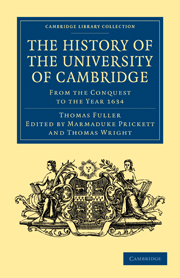Book contents
- Frontmatter
- THE EDITOR'S PREFACE
- HISTORY OF THE UNIVERSITY OF CAMBRIDGE SINCE THE CONQUEST
- Dedication
- PREFACE
- REVERENDISSIMO ANTISTITI, JACOBO USSERIO, ARCHIEPISCOPO ARMACHANO, Domino suo colendissimo
- SECTION II
- DOMINO GULIELMO PASTON, DE PASTON IN COM. NORF. EQUITI AURATO, Patrono meo colendissimo
- SECTION III
- ROULANDO LITTON, In pago Hertfordensi Armigero
- SECTION IV
- RADULPHO FREEMAN, In Comitatu Hertfordensi Armigero
- SECTION V
- EDV. BENLOSSIO, Armigero, Mecænati suo benevolo
- SECTION VI
- EDVARDO PALMER, DE WALTHAM ARMIGERO
- SECTION VII
- TO FRANCIS ASH, Of London, Esquire
- SECTION VII
- THOMÆ PLAYER Armigero, Camerarii Londinensis primogenito
- SECTION VIII
- A PRAYER
- INDEX
SECTION IV
Published online by Cambridge University Press: 05 March 2012
- Frontmatter
- THE EDITOR'S PREFACE
- HISTORY OF THE UNIVERSITY OF CAMBRIDGE SINCE THE CONQUEST
- Dedication
- PREFACE
- REVERENDISSIMO ANTISTITI, JACOBO USSERIO, ARCHIEPISCOPO ARMACHANO, Domino suo colendissimo
- SECTION II
- DOMINO GULIELMO PASTON, DE PASTON IN COM. NORF. EQUITI AURATO, Patrono meo colendissimo
- SECTION III
- ROULANDO LITTON, In pago Hertfordensi Armigero
- SECTION IV
- RADULPHO FREEMAN, In Comitatu Hertfordensi Armigero
- SECTION V
- EDV. BENLOSSIO, Armigero, Mecænati suo benevolo
- SECTION VI
- EDVARDO PALMER, DE WALTHAM ARMIGERO
- SECTION VII
- TO FRANCIS ASH, Of London, Esquire
- SECTION VII
- THOMÆ PLAYER Armigero, Camerarii Londinensis primogenito
- SECTION VIII
- A PRAYER
- INDEX
Summary
The large privilege of Cambridge for printing.
A. D. 1400. 2 Hen. IV.
Sir Edward Coke, 4th part of his Instit. of the Jurisdict. of Courts, p. 228.
Over into England about this time first came the mystery of printing; but when first brought to Cambridge, it is uncertain. Only I hope I may without offence report what I have read in the oracle of our English law: This University of Cambridge hath power to print within the same “omnes” and “omnimodos libros”; which the University of Oxford hath not.
much improved therem.
Cai. Hist. Cant. Acad. lib. n. p. 127.
2. True it is, it was a great while before Cambridge could find out the right knack of printing, and therefore they preferred to employ Londoners therein. Thus I find a book of Robert Alynton's, called Sophistica Principia, printed at London by Wynand de Word, ad usum Cantabrigiensem, Anno 1510. But some seven years after, one Sibert, University Printer, improved that mystery to good perfection, fairly setting forth the book of Erasmus, “de conscribendis epistolis”, the author then living in Cambridge, who may be presumed curious in the impression of his works. In the next age Thomas Thomatius, fellow of King's, and Cambridge printer, (known by the dictionary of his name) heightened printing to higher degree; since exactly completed by his successors in that office; witness the Cambridge bible, of which none exacter or truer edition in England.
A. D. 1401. 2 Hen. IV. August 18.
The University visited by the Archbishop of Canterbury.
3. This year the University was visited by Thomas Arundel, Archbishop of Canterbury, the first and last of his place, personally appearing in that employment.
- Type
- Chapter
- Information
- The History of the University of CambridgeFrom the Conquest to the Year 1634, pp. 126 - 142Publisher: Cambridge University PressPrint publication year: 2009First published in: 1840



